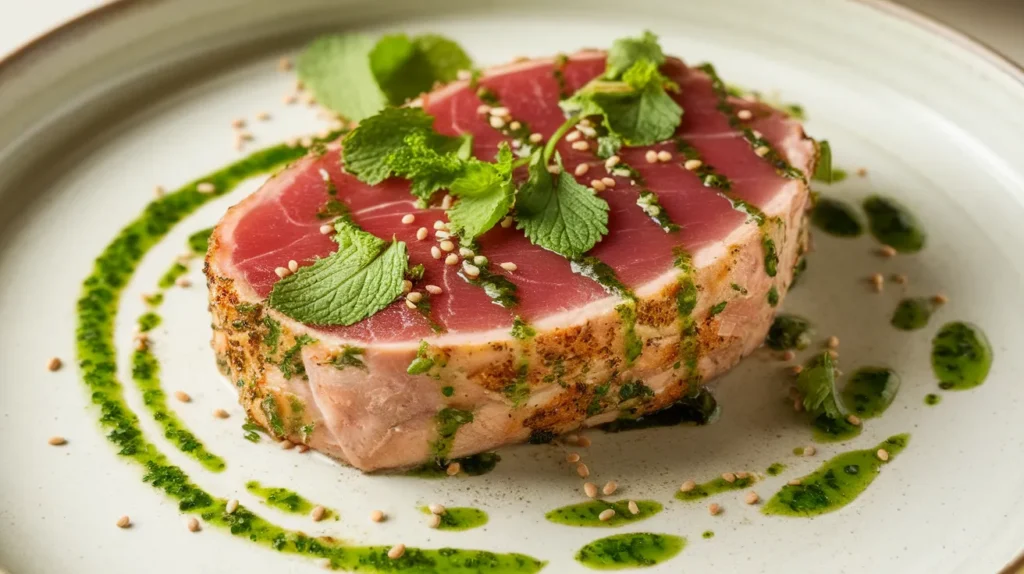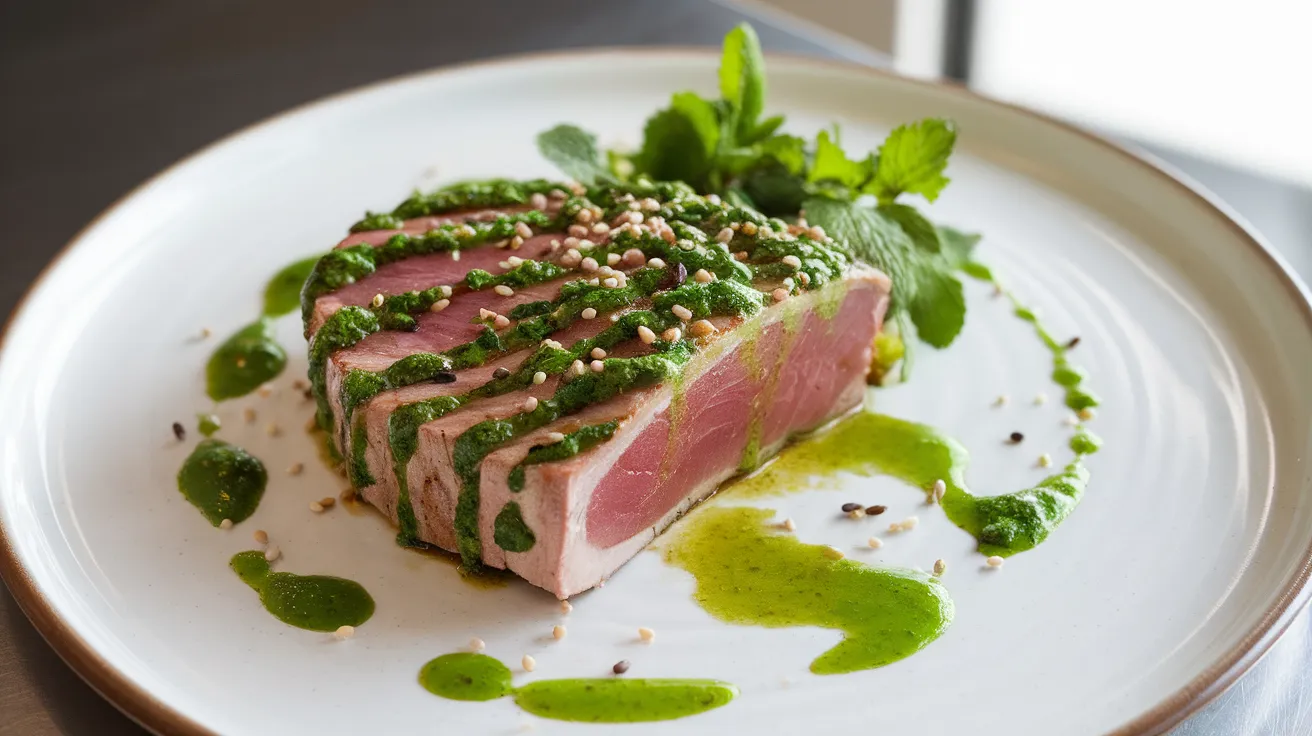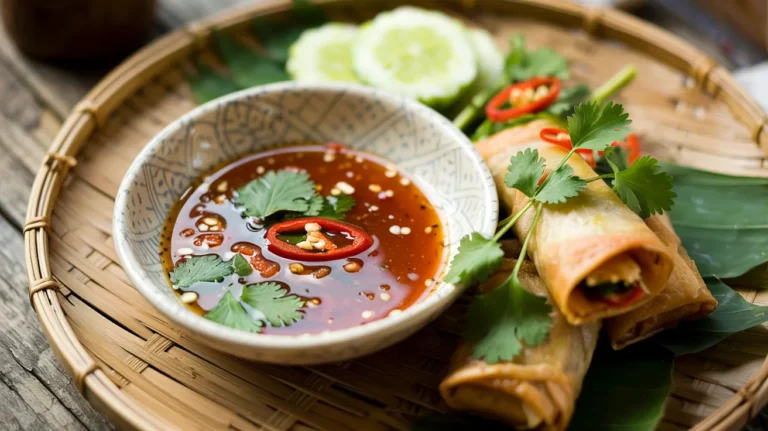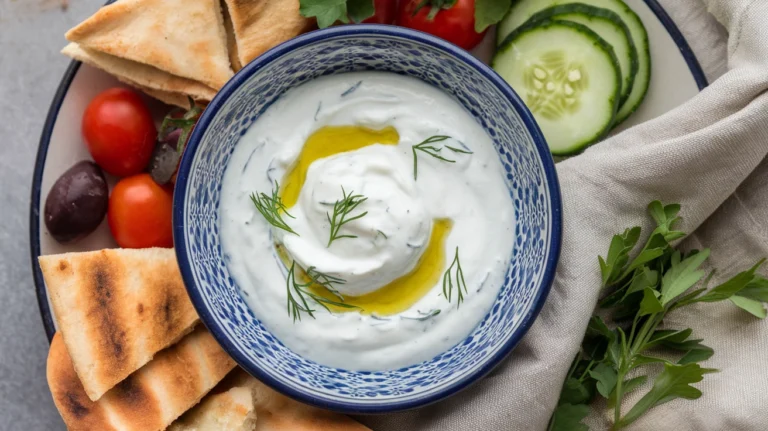This restaurant-quality sauce for yellowfin tuna brings out the best in your fresh fish with bright citrus, aromatic herbs, and subtle Asian flavors. Our beginner-friendly sauce for yellowfin tuna recipe creates the ideal balance of acidity and richness that complements tuna’s natural taste without masking its delicate texture.
RECIPE INFO
SERVES: 4 | PREP: 15 MIN | COOK: 10 MIN | TOTAL: 25 MIN
Ingredients
For the Base Sauce
| Ingredient | Amount |
|---|---|
| Fresh lime juice | 3 tablespoons |
| Extra virgin olive oil | 1/4 cup |
| Fresh ginger, minced | 1 tablespoon |
| Garlic cloves, minced | 3 cloves |
| Soy sauce (low sodium) | 2 tablespoons |
| Rice vinegar | 1 tablespoon |
Fresh Aromatics
| Ingredient | Amount |
|---|---|
| Fresh cilantro, chopped | 1/4 cup |
| Green onions, sliced thin | 2 stalks |
| Fresh mint leaves, chopped | 2 tablespoons |
| Jalapeño, seeded and minced | 1 small |
Finishing Touches
| Ingredient | Amount |
|---|---|
| Sesame oil | 1 teaspoon |
| Honey | 1 tablespoon |
| Sea salt | 1/2 teaspoon |
| Black pepper, freshly ground | 1/4 teaspoon |
| Sesame seeds, toasted | 1 tablespoon |
Step-by-Step Instructions for Beginners
Phase 1: Complete Preparation (8 minutes)
1. Set Up Your Workspace Clear a large area on your counter. Place a medium mixing bowl, whisk, and measuring tools within easy reach. Set out small prep bowls for each ingredient – this French cooking technique called “mise en place” prevents mistakes and makes cooking smoother.
2. Juice the Limes Properly Roll each lime on the counter while pressing down firmly – this breaks the internal membranes and releases more juice. Cut limes in half and squeeze through a fine strainer to remove seeds and pulp. You need exactly 3 tablespoons, which usually takes 1.5-2 large limes.
3. Prepare Fresh Ginger Like a Pro Use a spoon edge to scrape off the ginger skin – it’s easier than peeling with a knife. Slice the ginger into thin coins, then stack the coins and cut into thin strips. Finally, mince the strips as finely as possible. The pieces should be no larger than rice grains to prevent overwhelming bites.
4. Master Garlic Mincing Place the flat side of your knife over each garlic clove and press firmly to crush it – the skin will slip off easily. Roughly chop the garlic, then sprinkle a pinch of salt over it. Use the flat side of your knife to drag and press the garlic against the cutting board repeatedly. This creates a smooth paste that distributes evenly in the sauce for yellowfin tuna.
5. Handle Fresh Herbs Correctly Wash cilantro and mint in cold water, then spin in a salad spinner or pat completely dry with paper towels. Wet herbs will make your sauce watery and cause it to spoil faster. Remove thick stems from cilantro and mint before chopping. Stack leaves and roll them tightly, then slice through the roll to create thin ribbons (chiffonade technique).
6. Prepare Jalapeño Safely Wear disposable gloves or wash hands immediately after handling. Cut jalapeño lengthwise and use a small spoon to scrape out seeds and white membrane – this removes most of the heat while keeping the flavor. Mince finely and set aside separately so you can add gradually to taste.
Phase 2: Building the Sauce Foundation (10 minutes)
7. Create the Acid Base In your medium bowl, combine lime juice, rice vinegar, and soy sauce. Whisk these together for 30 seconds until completely combined. This acidic base is crucial for balancing the richness of both the oil and the tuna. The mixture should look uniform with no separation.
8. Make a Proper Emulsion Here’s where many beginners struggle: slowly drizzle the olive oil into the acid mixture while whisking constantly in a circular motion. Add the oil drop by drop at first, then in a thin stream. This technique prevents the oil from separating and creates a creamy, cohesive base for your sauce for yellowfin tuna. The mixture should thicken slightly and become pale yellow.
9. Incorporate Aromatics Gradually Add your minced ginger paste and garlic paste to the emulsified base. Whisk vigorously for 45 seconds to fully distribute these strong flavors. The ginger should be completely invisible in the mixture – if you see chunks, mince it finer next time.
10. Balance with Sweetness Drizzle in the honey while whisking continuously. The honey helps bind the ingredients and balances the sharp acidity. Make sure it completely dissolves – you shouldn’t see any golden streaks or sticky spots. If the honey seems thick, warm it slightly in the microwave for 10 seconds first.
11. Season the Base Carefully Add sea salt and black pepper gradually, whisking after each addition. Taste the base sauce now – it should be bright, balanced, and slightly salty. Remember that you’ll add fresh herbs next, which will mellow these flavors slightly.
Phase 3: Adding Fresh Elements (5 minutes)
12. Fold in Herbs Properly Switch from whisking to gentle folding motions using a rubber spatula. Add the chopped cilantro and mint in two additions, folding carefully to avoid bruising the leaves. Bruised herbs turn dark and bitter. The folding motion should go under the mixture, up the sides, and over the top.
13. Add Green Onions and Heat Fold in the sliced green onions first – they’re sturdy and won’t bruise. Then add minced jalapeño one small pinch at a time, tasting between additions. Start with half of what you prepared and add more as needed. Remember: you can always add heat, but you can’t remove it.
14. Check Seasoning and Adjust Taste your sauce for yellowfin tuna now. It should be bright, herbaceous, with gentle heat and balanced salt levels. If it tastes flat, add more lime juice. If too acidic, add a touch more honey. If it needs more depth, add a pinch more salt.
Phase 4: Final Touches and Finishing (2 minutes)
15. Add Sesame Oil for Depth Drizzle the sesame oil around the edge of the bowl, then fold it in gently. Sesame oil is very strong – don’t add more than the recipe calls for. This ingredient adds a nutty richness that complements tuna beautifully.
16. Final Seasoning Check Taste one final time and adjust if needed. The flavors should be harmonious with no single element dominating. Let the sauce sit for 2-3 minutes to allow flavors to meld.
17. Add Textural Finish Just before serving, sprinkle toasted sesame seeds over the top. Don’t stir them in – they provide visual appeal and textural contrast. If your sesame seeds aren’t toasted, heat them in a dry pan for 2-3 minutes until golden and fragrant.
Professional Chef’s Notes
Timing is Critical: This sauce for yellowfin tuna reaches peak flavor 10-15 minutes after completion. The herbs stay bright, but flavors have time to marry. Don’t make it more than 30 minutes ahead.
Quality Ingredient Impact: Fresh lime juice makes or breaks this recipe. Bottled juice creates a flat, artificial taste that won’t complement your expensive tuna properly.
Temperature Matters: Always serve this sauce at room temperature. Cold temperatures mute the delicate herb flavors and make the olive oil taste heavy.
Tuna Pairing Strategy: This sauce works with seared, grilled, poached, or even sashimi-grade raw tuna. The acidity helps cut through the fish’s richness while enhancing its natural flavors.
Nutrition Information (Per Serving)
- Calories: 95
- Protein: 1g
- Carbohydrates: 6g
- Fat: 8g
- Fiber: 0.5g
- Sodium: 380mg
Creative Sauce for Yellowfin Tuna Variations
Tropical Mango Heat Version
Transform your basic sauce for yellowfin tuna by folding in 1/2 cup finely diced mango and doubling the jalapeño. The mango’s sweetness balances the extra heat perfectly. This variation pairs beautifully with our sauce for white fish when serving multiple seafood dishes.
Mediterranean-Style Adaptation
Replace Asian elements with fresh basil instead of cilantro, lemon juice for lime, and add 2 tablespoons capers. This creates a completely different flavor profile while maintaining the same technique.
Creamy Avocado Enhancement
Blend 1 ripe avocado into the finished sauce for richness and beautiful green color. This creates a more substantial sauce that works as both a sauce and side dish.
Protein-Friendly Version
Double the ginger and add 1 tablespoon white miso paste for umami depth. The same flavor-building principles work wonderfully for our sauce for grilled pork chops too.
Storage & Reheating Guidelines
Refrigerator Storage: Cover tightly and refrigerate up to 3 days. The herbs will darken slightly after day two, but the flavor remains excellent.
Freezing: Never freeze this sauce for yellowfin tuna. Fresh herbs become mushy and the emulsion breaks when thawed.
Before Serving: Remove from refrigerator 15 minutes before serving to reach room temperature. Stir gently to recombine – don’t whisk vigorously or you’ll bruise the herbs.
Make-Ahead Strategy: Prepare the base sauce without fresh herbs up to 24 hours ahead. Add cilantro, mint, and green onions just before serving for maximum freshness.

Detailed Troubleshooting Guide
Problem: Sauce tastes too acidic or sharp
Solution: The lime juice overpowered other flavors. Add 1 extra teaspoon honey and a pinch of salt. Taste and repeat if necessary. Next time, use less lime juice or add it gradually while tasting.
Problem: Oil separates and won’t emulsify
Solution: You added oil too quickly. Transfer mixture to a blender and pulse 3-4 times, or whisk vigorously while adding 1 teaspoon warm water. The emulsion should reform within 30 seconds.
Problem: Flavors taste muted or flat
Solution: Check your lime juice freshness – old juice tastes flat. Add a generous pinch of salt to brighten all flavors. Also ensure herbs are completely fresh and properly chopped.
Problem: Accidentally made it too spicy
Solution: Stir in extra honey (1-2 teaspoons) and lime juice to balance the heat. Don’t add dairy as it will change the sauce texture completely.
Problem: Fresh herbs turned brown quickly
Solution: Herbs weren’t completely dry before chopping. Next time, pat herbs dry thoroughly and store finished sauce with plastic wrap pressed directly onto the surface to prevent oxidation.
Essential Equipment List
- Medium glass or stainless steel mixing bowl (plastic retains flavors)
- Wire balloon whisk (creates better emulsions than fork)
- Sharp 8-inch chef’s knife for precise mincing
- Separate cutting board (never use the same board as raw fish)
- Liquid and dry measuring cups
- Small prep bowls (at least 6 small bowls for organization)
- Rubber spatula for gentle folding
- Fine-mesh strainer (for lime juice)
Complete Shopping List
Produce Section
- 2 large fresh limes (for 3 tablespoons juice)
- 1 piece fresh ginger (2-3 inch piece)
- 1 head garlic (you need 3 large cloves)
- 1 bunch fresh cilantro
- 1 package fresh mint
- 1 bunch green onions
- 1 small jalapeño pepper
Pantry and Condiment Items
- Extra virgin olive oil (cold-pressed preferred)
- Pure sesame oil (not blended)
- Low-sodium soy sauce
- Rice vinegar (unseasoned)
- Pure honey
- Sesame seeds (raw or pre-toasted)
- Sea salt
- Whole black peppercorns (for freshest flavor)
Expert Success Secrets
1. Temperature Control: Both your sauce for yellowfin tuna and the fish should be at room temperature when served together. This allows all flavors to shine at their peak intensity.
2. Fresh Herb Rule: Never substitute dried herbs in this recipe. The fresh elements are what make this sauce exceptional and worth the extra shopping effort.
3. Taste and Adjust Philosophy: Every lime has different acidity levels, every jalapeño has different heat. Always taste your sauce and adjust seasonings before serving. Your palate is the best guide.
4. Gentle Technique: Overmixing bruises delicate herbs and creates muddy colors. Use folding motions after adding herbs, never aggressive stirring or whisking.
5. Timing Strategy: Make this sauce for yellowfin tuna after your tuna is cooked and resting. This prevents herbs from wilting while you’re busy cooking and ensures everything comes together at the perfect moment.
This comprehensive sauce for yellowfin tuna recipe transforms any tuna preparation into a restaurant-quality dish. The combination of bright citrus, aromatic fresh herbs, and subtle Asian flavors creates the perfect complement to tuna’s rich, meaty texture without overwhelming its delicate taste.




